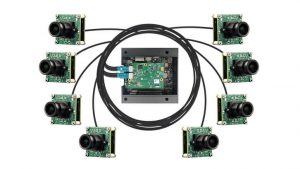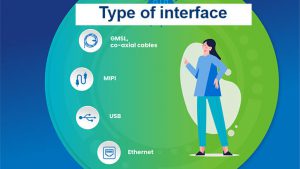Choosing the right processor for your multi-camera application
Multi-camera applications have become increasingly popular across various industries. From surveillance systems to autonomous vehicles and robotics, the demand for processors capable of handling multiple camera inputs has grown significantly.
Therefore, selecting the right processor for your multi-camera application is crucial to ensure optimal performance, power efficiency, thermal management, interface compatibility, and software support.
In this blog, you’ll uncover the role of processors in multi-camera applications and the key criteria for choosing a suitable processor. Also, find out some of the popular products by e-con Systems that empower multi-camera systems.
Role of processors in multi-camera applications
Processors play a pivotal role in multi-camera solutions, serving as the computational powerhouse behind the efficient handling and processing of multiple camera inputs. They enable real-time video streaming, advanced image analysis, and complex computer vision algorithms. Processors with high-performance capabilities, such as high TOPS (Trillions of Operations Per Second) ratings, allow for seamless data processing from multiple cameras simultaneously.
With their ability to handle extensive computational tasks and interface with various camera modules, processors form the backbone of multi-camera solutions.
Top criteria for selecting a processor for your multi-camera application
Maximum camera support

When evaluating processors, consider the maximum number of cameras they can support simultaneously. This specification is crucial for applications that demand multiple camera inputs for real-time monitoring or complex vision processing tasks. Ensure that the processor you choose aligns with the specific camera requirements of your application.
TOPS
TOPS is a critical metric that reflects the processing power of a processor, especially for computationally intensive multi-camera applications. Higher TOPS values indicate the ability to handle complex algorithms and image-processing tasks efficiently. Assess the TOPS rating of a processor to ensure it can handle the workload of your multi-camera application without performance bottlenecks.
Power consumption
Power efficiency is vital for applications where low power consumption is a priority, such as mobile or battery-operated devices. Evaluate the power consumption of the processor under various operating conditions to ensure it aligns with your application’s power constraints. Opting for a power-efficient processor can significantly impact the overall energy consumption and battery life of your multi-camera system.
Thermal performance
Multi-camera applications often generate substantial heat, especially when processing high-resolution video streams or performing intensive image analysis. Choosing a processor with efficient thermal management capabilities is crucial to prevent overheating and ensure long-term reliability. Evaluate the thermal performance of the processor and consider additional cooling solutions if necessary.
Type of interface

Consider the type of camera interfaces supported by the processor. Common interfaces include MIPI CSI, Ethernet, USB, and HDMI. Assess the compatibility of the processor with the camera modules you intend to use, ensuring seamless integration and data transfer between the cameras and the processor.
Software ecosystems
The availability of a robust software ecosystem is vital for the efficient development and support of multi-camera applications. Look for processors that offer comprehensive software development kits (SDKs), libraries, and APIs tailored to camera integration, image processing, and computer vision tasks. A well-supported software ecosystem can accelerate application development, enhance functionality, and facilitate future updates and optimisations.
e-con Systems’ products that support multi-camera applications
With a strong background of 20 years in the industry, e-con Systems has developed an adapter board specifically designed to enhance the multi-camera capabilities of the RB5 Kit. This empowers users to connect and utilise up to six cameras concurrently, whether MIPI, GMSL2 or a combination of both. So, you can capture highly detailed images and videos from multiple angles, opening up a world of possibilities for your embedded vision applications.
Some of the multi-camera solutions include:
- NileCAM130M_CUQRB5 -13.0 MP Monochrome GMSL2 Camera
- NileCAM210_CUQRB5 – 2.0 MP Ultra-Low Light IMX462 GMSL2 Camera
- NileCAM82_CUQRB5– 8.0 MP Ultra-Low Light IMX485 GMSL2 Camera
- NileCAM81_CUOAGX – AR0821 4K HDR GMSL2 Camera
- e-CAM85_CUQRB5 – Sony Starvis IMX715 Camera
- e-CAM21_CUQRB5 – Full HD HDR Camera
- e-CAM0M30_TOF_CUQRB5 – 3D Time of Flight (ToF) Camera
- e-CAM82_CUQRB5 – 4K SONY STARVIS IMX485 Ultra Low Light camera
- e-CAM130M_CUQRB5 – 13MP AR1335 Monochrome Cameras
- e-CAM210_CUQRB5 – Sony Starvis IMX462 Camera
- e-CAM25_CUQRB5- Global Shutter Camera
- e-CAM180_CUXVR – Six Synchronised 18MP Cameras
- e-CAM130A_CUXVR_3H02R1 Multi-Camera Solution with 180° Image Stitching
- e-CAM27_CUOAGX – 2MP OV2312 Global Shutter RGB-IR Camera
- e-CAM20_CUOAGX – Six Synchronised Global Shutter Camera
- e-CAM81_CUXVR – AR0821 4K HDR Cameras
- e-CAM180_CUOAGX- 18MP AR1820HS Six Synchronised Cameras
- e-CAM25_CUXVR – Six Synchronised Global Shutter Cameras
- e-CAM24_CUXVR – 2MP Global Shutter Monochrome Camera


